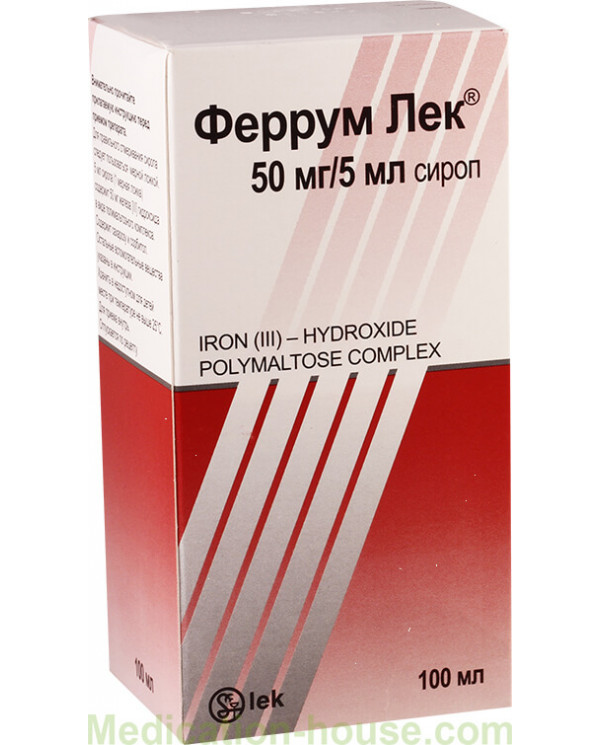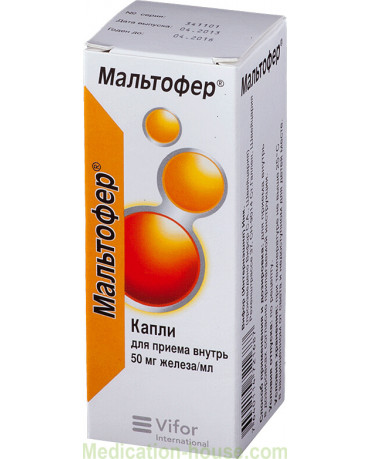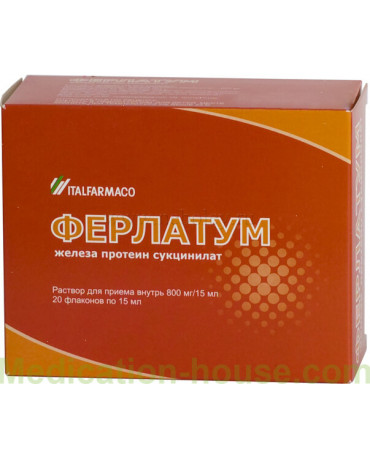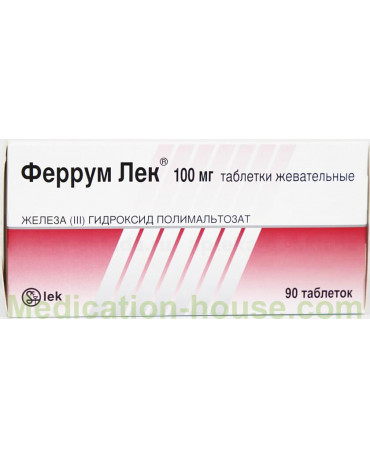Instruction for Ferrum Lek syrup
You can buy Ferrum Lek syrup here
Composition
5 ml of syrup contains:
Active ingredient: iron (in the form of iron (III) hydroxide polymaltosate) 50 mg;
Excipients: sucrose, sorbitol, methyl parahydroxybenzoate, propyl parahydroxybenzoate, ethanol, creamy essence, purified water
pharmachologic effect
Ferrum Lek syrup is an antianemic drug.
Pharmacodynamics
The molecular weight of the complex is so great - about 50 kDa - that its diffusion through the gastrointestinal mucosa is 40 times slower than diffusion of ferrous iron. The complex is stable and does not release iron ions under physiological conditions. The iron of the multinuclear active zones of the complex is bound into a structure similar to that of the natural compound of iron, ferritin. Due to this similarity, the iron of this complex is absorbed only by active absorption. Iron-binding proteins located on the surface of the intestinal epithelium absorb iron (III) from the complex through competitive ligand exchange. Absorbed iron is mainly deposited in the liver, where it binds to ferritin. Later in the bone marrow, it is included in hemoglobin.
The iron (III) complex polymaltose hydroxide does not possess the prooxidant properties inherent in iron (II) salts.
Pharmacokinetics
Studies using the double isotope method (55Fe and 59Fe) showed that iron absorption, as measured by hemoglobin in red blood cells, is inversely proportional to the dose taken (the higher the dose, the lower the absorption). There is a statistically negative correlation between the degree of iron deficiency and the amount of iron absorbed (the higher the iron deficiency, the better the absorption). Iron is most absorbed in the duodenum and jejunum.
The remaining (unabsorbed) iron is excreted in feces. Its excretion with exfoliating gastrointestinal and skin epithelial cells, as well as with sweat, bile and urine, is approximately 1 mg of iron per day. In women, during menstruation, an additional loss of iron occurs, which must be taken into account.
Indications
treatment of latent iron deficiency;
treatment of iron deficiency anemia;
prevention of iron deficiency during pregnancy.
Pregnancy and lactation
In the course of controlled studies in pregnant women (II, III trimesters of pregnancy), there was no negative effect on the mother and fetus. There were no harmful effects on the fetus when taking drugs in the first trimester of pregnancy.
Contraindications
hypersensitivity to the components of the drug;
excess iron in the body (hemochromatosis, hemosiderosis);
violation of the mechanisms of utilization of iron (lead anemia, sidereal anemia, thalassemia);
anemia not associated with iron deficiency (e.g. hemolytic, megaloblastic, caused by a lack of cyanocobalamin).
rare hereditary forms of fructose intolerance, glucose-galactose malabsorption and sucrose-isomaltase deficiency (because the drug contains sucrose and sorbitol).
Precautions: diabetes mellitus (for syrup); bronchial asthma; chronic polyarthritis; cardiovascular failure; low ability to bind iron and / or folic acid deficiency.
Side effects
The reported side effects were mostly mild and transient.
According to WHO, adverse reactions are classified according to their frequency of development as follows: very often (≥1 / 10), often (≥1 / 100,
From the gastrointestinal tract: very rarely - pain in the abdomen, nausea, constipation, diarrhea, dyspepsia, vomiting, discoloration of feces (due to excretion of non-absorbed iron, has no clinical value).
On the part of the skin and subcutaneous tissue: very rarely - urticaria, rash, itching of the skin.
Interaction
Interaction with other drugs or food products has not been identified.
The simultaneous use of iron with parenteral preparations of iron and other iron (III) oral preparations is not recommended due to pronounced inhibition of absorption of iron ingested orally.
How to take, course of administration and dosage
Inside, during or immediately after a meal.
The daily dose can be divided into several doses or taken at a time.
Syrup Ferrum Lek can be mixed with fruit or vegetable juices or added to baby food.
Doses and duration of treatment depend on the degree of iron deficiency.
The measuring spoon enclosed in the package is used to accurately dispense Ferrum Lek syrup.
Iron-deficiency anemia
The duration of treatment is about 3-5 months. After normalizing the hemoglobin level, you should continue taking the drug for a few more weeks to replenish iron stores in the body.
Children under the age of one year: 2.5 ml (½ scoop) - 5 ml (1 scoop) of Ferrum Lek syrup per day.
Children aged 1 to 12 years: 5–10 ml (1–2 scoops) of Ferrum Lek syrup per day.
Children over 12 years old, adults and mothers who are breast-feeding a child: 10–30 ml (2–6 scoops) of Ferrum Lek syrup.
Latent iron deficiency
The duration of treatment is about 1-2 months.
Children aged 1 to 12 years: 2.5–5 ml (1/2 to 1 measuring spoon) of Ferrum Lek syrup per day.
Children over 12 years old, adults and mothers who are breastfeeding: 5–10 ml (1–2 scoops) of Ferrum Lek syrup per day.
Pregnant women
Iron deficiency anemia: 20–30 ml (4–6 measured spoons) of Ferrum Lek syrup until the hemoglobin level is normalized. After this, you should continue to take 10 ml (2 scoops) of syrup per day, at least until the end of pregnancy to replenish iron stores in the body.
Latent iron deficiency and prevention of iron deficiency: 5-10 ml (1-2 scoops) of Ferrum Lek syrup per day.
Overdose
Symptoms: with an overdose of syrup or chewing tablets Ferrum Lek, there were no signs of intoxication or excess iron in the body, because iron from the active substance is not present in the digestive tract in free form and is not absorbed by passive diffusion.
Treatment: symptomatic; as an antidote, deferoxamine is slowly injected intravenously (15 mg / kg / h), depending on the severity of the overdose, but not more than 80 mg / kg / day. Hemodialysis is ineffective.
Special instructions
For children under 12 years of age, in connection with the need to prescribe low doses of the drug, it is preferable to prescribe Ferrum Lek in the form of a syrup.
Neither chewable tablets nor Ferrum Lek syrup cause staining of tooth enamel.
In cases of anemia caused by an infectious or malignant disease, iron accumulates in the reticuloendothelial system, from which it is mobilized and utilized only after the underlying disease has been cured.
When using syrup Ferrum Lek, the stool can be painted in dark color, which does not have any clinical significance. Iron supplementation does not affect latent bleeding test results (selective for hemoglobin).
Notification for diabetics: 1 ml of Ferrum Lek syrup contains 0.04 XE.
Influence on the ability to drive a car or perform work that requires an increased speed of physical and mental reactions. The drug does not affect the ability to concentrate.
Terms of sell
You can buy syrup Ferrum Lek without a prescription.





